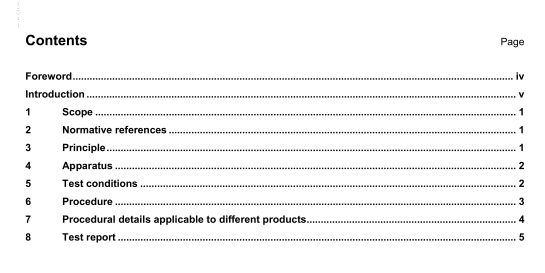ISO 2878 pdf download – Rubber —Antistatic and conductive products – Determination of electrical resistance.
4 Apparatus
4.1 Test instruments
The test shall be made with an instrument havmg a nominal open circuit voltage of 500 V DC. preferably an insulation tester (ohmmeter), or with any suitable Instrument known to give comparable results
The Instrument shall be sufficiently accurate to determine the resistance to wIthin 10 % and shall not dissipate more than 3W en the product.
The resistance values obtained will vary with the applied voltage, and errors may occur when low test voltages are involved. In cases of dispute, the voltage applied to the product shall be not less than 40 V. except where this conflicts with the requirement not to dissipate more than 3W in the test piece.
4.2 Electrodes and contacts
Unless otherwise specified in the product standard, electrodes shall be formed on the surface by means of a conductive silver lacquer, colloidal graphite or a conductive liquid of the following composLion:
anhydrous polyethylene glycol (of molecular mass 600): 800 parts by mass; water: 200 parts by mass:
— any suitable wetting agent: 1 part by mass;
— potassium chlonde: 10 parts by mass.
When a conductrve liquid is used, the electrode contact area shall be completely wetted and shall remain so until the end of the test,
The conductive silver lacquer or colloidal graphite shall be dried in air at standard laboratory temperature; the surface resistivity of the dried tim shall be below 1000.
Clean metal contacts shall be applied to the electrodes so that the contact area Is approximately the same s*ze as. but not greater than, the electrodes, except where otherwise stated.
The surface of the product shall not be deformed either dunng the application of the contacts or during the test, unless specified in the product standard. The product shall be supported on an insulating surface except when otherwise specified. The insulating surface shall be such that its volume resistivity is greater than 1Q1U Om or sufficiently great that, when using two electrodes as described in 7.1 on the insulating surface, the resistance is too great to be indicated using the instrument used to test the product.
All the test results shal be within the specified limits unless otherwise stated.
7 Procedural details applicable to different products
7.1 Tests on one surface
Apply electrodes to two areas, each a square with sides approximately 25 mm long, such that the distance between the facing edges is (SD ±5) mm and located on the same surface of the product being tested. Apply the metal contacts to the electrodes and measure the resistance.
7.2 Tests between two surfaces
Apply electrodes to two areas, each approximately 25 mm square The test areas shall be located so that the results represent the electncal resistance of the normal discharge path In the working conditions anticipated. Specifications for particular products will normally state the location of the test areas
Apply the metal contacts to the electrodes and measure the resistance
7.3 Tests on products bonded or clamped to metal parts
7.3.1 Products bonded or clamped to oni metal part
Apply an electrode to an area as nearly as possIble 25mm square on the working surface of the product the area shall not extend to other surfaces,
Apply a metal contact to the electrode and measure the resistance from this contact to the bonded or clamped metal.
7.3.2 Products bonded or clamped to two metal parts Measure the resistance between the metal parts.
7.4 Tests on tubular products
7.4.1 Tests between InsIds surface and outsIde surface
Two tests shall be carried out In accordance with a) and b):
a) Apply electrodes on the inside surface at one end (A) of the tubing and on the outside surface at the other end (B). The electrodes shall be 25 mm wide bands extending round the complete circumference.
ISO 2878 pdf download – Rubber —Antistatic and conductive products – Determination of electrical resistance
